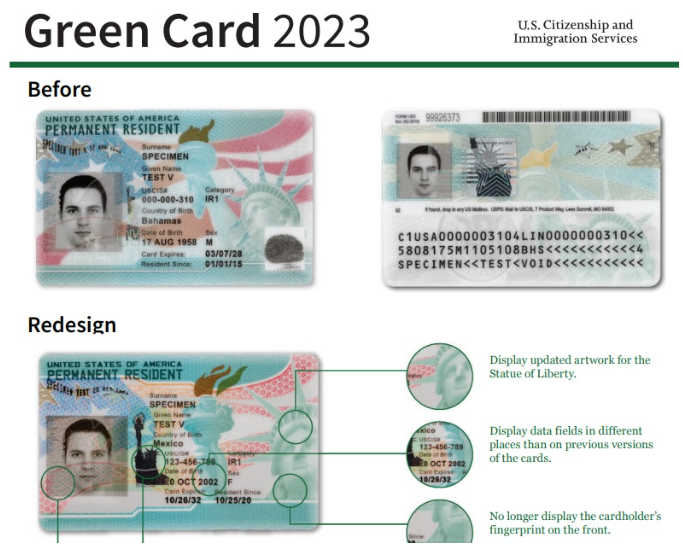USCIS Releases Design for Green Cards
Green Cards: A Guide to USCIS Design, Eligibility, and the Application Process

One of USCIS initiatives is the USCIS Design for Green Cards, which aims to create a new and improved form of identification for immigrants. This new design will include biometric security measures, such as facial recognition, iris scans, and unique fingerprints, along with personal information such as name, date of birth, and place of birth.
Renewing or Replacing a Green Card
Green Cards have a limited validity period and must be renewed or replaced to remain valid. To renew or replace a Green Card, an individual must fill out the appropriate forms and submit them to the USCIS, along with evidence of eligibility and the appropriate fees. Once the forms and fees have been accepted, the individual will be issued a new Green Card.
The USCIS Green Card Design Process
U.S. Citizenship and Immigration Services (USCIS) announces new designs for Permanent Resident Cards (Green Cards) and Employment Authorization Documents (EADs) aimed at improving security.
The updated cards will feature advanced technology such as improved artwork, secure holographic images, layer-reveal feature, and different placement of data fields. The new designs will be introduced on January 30, 2023 and the current cards will remain valid until their expiration date.
The USCIS will continue using existing cardstock until supplies run out and some cards may still display the older design. Both the old and new designs will be accepted for Form I-9, Employment Eligibility Verification, E-Verify, and Systematic Alien Verification for Entitlements (SAVE).
USCIS encourages those with older Green Cards without an expiration date to apply for a replacement to prevent fraud or tampering.
The Secure Identification Platform (SIP) Project, which includes redesigning the cards every 3-5 years, was launched in 2019 after extensive market research and consultations with key industry leaders.
Immigration Requirements for a Green Card
Individuals must meet certain immigration requirements to obtain a Green Card, including a valid visa, permanent residency, a qualifying family relationship, a job offer from a U.S. employer, or being a refugee or asylee. In addition, they must pass a background check and medical examination, as well as provide proof of financial stability. Once these requirements are met, individuals can begin the application process.
Who is eligible to apply for a Green Card?
In order to be eligible to apply for a Green Card, an individual must have a lawful status in the United States, whether it be through a valid visa, permanent residency, or citizenship. To be eligible, an individual must also meet specific requirements, such as having a qualifying family relationship, a job offer from a U.S. employer, or being a refugee or asylee. For more information you can visit https://www.uscis.gov/green-card/green-card-eligibility-categories
Benefits of a Green Card
Having a Green Card provides a range of benefits to individuals, including the ability to live and work in the United States, travel freely, and access public benefits such as healthcare. Additionally, having a Green Card makes it easier for individuals to become U.S. citizens if they choose to do so.
Risks of Not Having a Green Card
Not having a valid Green Card can result in serious consequences, including being subject to deportation and being barred from re-entering the United States. Furthermore, individuals without a valid Green Card may have difficulty accessing public benefits, such as healthcare.
How to Apply for a Green Card
To apply for a Green Card, individuals must first meet certain eligibility criteria, such as having a valid passport, U.S. visa, and a sponsor. After meeting these requirements, the individual must submit Form I-485, which is an application for permanent residency or adjusting status, along with supporting documentation, such as proof of identity, financial documents, and a medical examination. If the application is approved, the individual will receive their Green Card in the mail.
Potential Challenges in Obtaining a Green Card
One of the challenges with obtaining a Green Card is the long waiting period, which can take several years for the application to be approved. Additionally, depending on the individual’s immigration status, their application may be denied. Additionally, there are several financial costs associated with applying for a Green Card, including filing fees, medical exam fees, and the cost of gathering supporting documentation.
It is also important to note that the Green Card application process can be complex and confusing, and it is not always clear what the USCIS is looking for or what is required. This can lead to misunderstandings and errors on the application, which can further delay the process or even result in denial.
However, with the right resources and guidance, the process of obtaining a Green Card can be made smoother and less stressful. There are many organizations that offer assistance with the application process, such as legal aid organizations and immigration advocacy groups. These organizations can provide guidance and support throughout the process, helping individuals to avoid common mistakes and navigate the requirements more easily.
In addition to seeking help from organizations, individuals can also find resources on the USCIS website, which provides helpful information about the eligibility requirements and the application process. The Department of State website also provides information about the visa application process and the validity of travel documents. With the right resources and support, individuals can successfully navigate the Green Card application process and achieve their goal of becoming a lawful permanent resident in the United States.
USCIS Unveils New Green Card Design with Enhanced Security Features
The United States Citizenship and Immigration Services (USCIS) has introduced a new and improved design for Green Cards and Employment Authorization Documents (EADs). This redesign comes with added security features, ensuring the protection against document tampering, counterfeiting, and fraud. Although the new cards have started being issued, the old ones will continue to work until they expire.
Eligibility Requirements for a Green Card 2023
Do you want to apply for a Green Card? There are various ways to do so, as specified by U.S. immigration laws. The eligibility requirements may vary based on the immigrant category you are applying under. Visit the Green Card Eligibility Categories page to see all possible categories and their eligibility requirements.
The General Application Process for a Green Card
The process of applying for a Green Card may differ based on your individual situation. However, most applicants go through the following general process:
- An immigrant petition must be filed for you by someone else (often referred to as sponsorship), or you may be eligible to file for yourself.
- Once USCIS approves the immigrant petition and there is a visa available in your category, you must file either a Green Card application with USCIS or a visa application with the U.S. Department of State.
- A biometrics appointment is necessary, where you will provide fingerprints, photos, and a signature.
- An interview will be conducted.
- You will receive a decision on your application.
Tracking Delivery of Your Green Card, EAD, and Travel Document
You can keep track of your Green Card, EAD, and Travel Document by signing up for a Case Status Online account. This will provide automatic case updates, including your U.S. Postal Service (USPS) tracking number once it is mailed to you.
You can also register for Informed Delivery through USPS. This service allows you to:
- Automatically track packages you are expecting
- Set up email and text alerts
- Enter USPS Delivery Instructions for your mail carrier
If your USPS tracking information shows that your package has been delivered but you have not received it, contact your local post office immediately. Note that your card or travel document will be mailed to the address specified on your application, unless you have provided different instructions on Form G-28.







